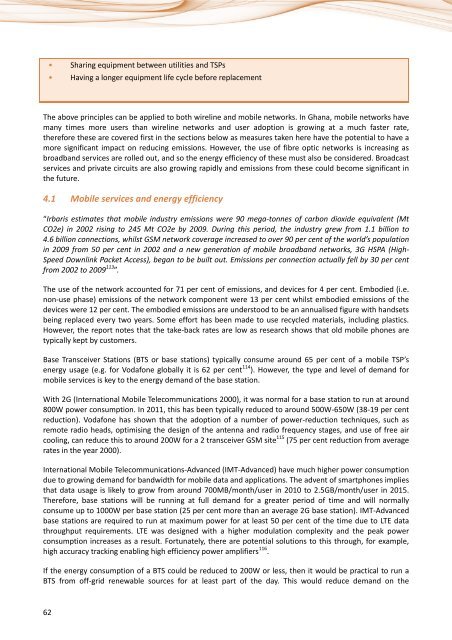Information and communication technologies (ICTs) and ... - ITU
Information and communication technologies (ICTs) and ... - ITU
Information and communication technologies (ICTs) and ... - ITU
You also want an ePaper? Increase the reach of your titles
YUMPU automatically turns print PDFs into web optimized ePapers that Google loves.
• Sharing equipment between utilities <strong>and</strong> TSPs<br />
• Having a longer equipment life cycle before replacement<br />
The above principles can be applied to both wireline <strong>and</strong> mobile networks. In Ghana, mobile networks have<br />
many times more users than wireline networks <strong>and</strong> user adoption is growing at a much faster rate,<br />
therefore these are covered first in the sections below as measures taken here have the potential to have a<br />
more significant impact on reducing emissions. However, the use of fibre optic networks is increasing as<br />
broadb<strong>and</strong> services are rolled out, <strong>and</strong> so the energy efficiency of these must also be considered. Broadcast<br />
services <strong>and</strong> private circuits are also growing rapidly <strong>and</strong> emissions from these could become significant in<br />
the future.<br />
4.1 Mobile services <strong>and</strong> energy efficiency<br />
“Irbaris estimates that mobile industry emissions were 90 mega-tonnes of carbon dioxide equivalent (Mt<br />
CO2e) in 2002 rising to 245 Mt CO2e by 2009. During this period, the industry grew from 1.1 billion to<br />
4.6 billion connections, whilst GSM network coverage increased to over 90 per cent of the world’s population<br />
in 2009 from 50 per cent in 2002 <strong>and</strong> a new generation of mobile broadb<strong>and</strong> networks, 3G HSPA (High-<br />
Speed Downlink Packet Access), began to be built out. Emissions per connection actually fell by 30 per cent<br />
from 2002 to 2009 113 ”.<br />
The use of the network accounted for 71 per cent of emissions, <strong>and</strong> devices for 4 per cent. Embodied (i.e.<br />
non-use phase) emissions of the network component were 13 per cent whilst embodied emissions of the<br />
devices were 12 per cent. The embodied emissions are understood to be an annualised figure with h<strong>and</strong>sets<br />
being replaced every two years. Some effort has been made to use recycled materials, including plastics.<br />
However, the report notes that the take-back rates are low as research shows that old mobile phones are<br />
typically kept by customers.<br />
Base Transceiver Stations (BTS or base stations) typically consume around 65 per cent of a mobile TSP’s<br />
energy usage (e.g. for Vodafone globally it is 62 per cent 114 ). However, the type <strong>and</strong> level of dem<strong>and</strong> for<br />
mobile services is key to the energy dem<strong>and</strong> of the base station.<br />
With 2G (International Mobile Tele<strong>communication</strong>s 2000), it was normal for a base station to run at around<br />
800W power consumption. In 2011, this has been typically reduced to around 500W-650W (38-19 per cent<br />
reduction). Vodafone has shown that the adoption of a number of power-reduction techniques, such as<br />
remote radio heads, optimising the design of the antenna <strong>and</strong> radio frequency stages, <strong>and</strong> use of free air<br />
cooling, can reduce this to around 200W for a 2 transceiver GSM site 115 (75 per cent reduction from average<br />
rates in the year 2000).<br />
International Mobile Tele<strong>communication</strong>s-Advanced (IMT-Advanced) have much higher power consumption<br />
due to growing dem<strong>and</strong> for b<strong>and</strong>width for mobile data <strong>and</strong> applications. The advent of smartphones implies<br />
that data usage is likely to grow from around 700MB/month/user in 2010 to 2.5GB/month/user in 2015.<br />
Therefore, base stations will be running at full dem<strong>and</strong> for a greater period of time <strong>and</strong> will normally<br />
consume up to 1000W per base station (25 per cent more than an average 2G base station). IMT-Advanced<br />
base stations are required to run at maximum power for at least 50 per cent of the time due to LTE data<br />
throughput requirements. LTE was designed with a higher modulation complexity <strong>and</strong> the peak power<br />
consumption increases as a result. Fortunately, there are potential solutions to this through, for example,<br />
high accuracy tracking enabling high efficiency power amplifiers 116 .<br />
If the energy consumption of a BTS could be reduced to 200W or less, then it would be practical to run a<br />
BTS from off-grid renewable sources for at least part of the day. This would reduce dem<strong>and</strong> on the<br />
62

















